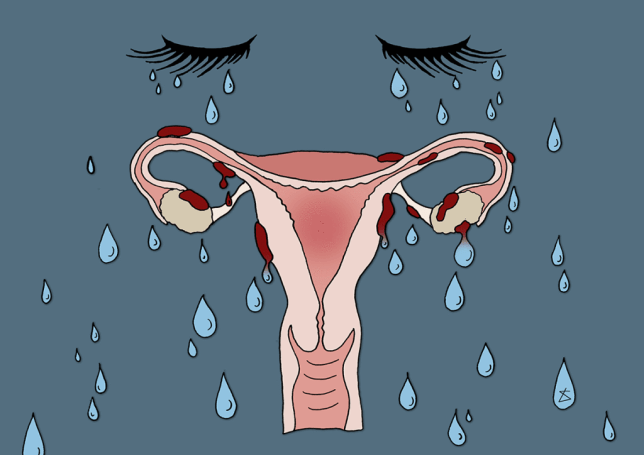Premenstrual Syndrome (PMS) is a broad term that typically refers to a general pattern of physical, emotional and behavioural symptoms occurring 1-2 weeks before, and remitting with the onset of menses. PMS is common, affecting from 30-80% of women of reproductive age, though clinically significant PMS symptoms have been reported in 3-8% of patients. PMS symptoms are different for every woman. You may get physical symptoms, such as bloating or gas, or emotional symptoms, such as sadness, or both. However, a more serious disorder associated with severe PMS symptoms is known as Premenstrual Dysphoric Disorder (PMDD).
As a woman, I have lost count of the number of times my emotions have been shunned by the other person saying, “Are you PMS-ing?”. The long standing traditional belief of a woman going “crazy” while she is on her period, wildly appropriates dismissing any sort of assertive behaviour from her. Menstruation, and the physical and psychological effects that it has on one’s body have always been deemed demeaning. Periods, and the accompanying premenstrual syndrome continue to be viewed as a woman’s fault instead of a natural process.
Your symptoms may also change throughout your life. Physical symptoms of PMS can include swollen or tender breasts, constipation or diarrhoea, bloating or a gassy feeling, cramping, headache or backache, clumsiness, and lower tolerance for noise or light. Whereas, emotional or mental symptoms of PMS may include irritability or hostile behaviour, feeling tired, sleep problems (sleeping too much or too little), appetite changes or food cravings, trouble with concentration or memory, tension or anxiety, depression, feelings of sadness, or crying spells, mood swings, and less interest in sex.
According to the Mayo Clinic, PMDD causes extreme mood shifts that can disrupt daily life, work and relationships. It consists of intense sadness, hopelessness and anxiety.
Some women get their periods without any signs of PMS or only very mild symptoms. For others, PMS symptoms may be so severe that it makes it hard to do everyday activities like go to work or school. PMS goes away when you no longer get a period, such as after menopause. After pregnancy, PMS might come back, but you might have different PMS symptoms.
Also read: #PeriodPositive: Don’t Apologise For PMS
Severe PMS symptoms may be a sign of premenstrual dysphoric disorder (PMDD). According to the medical experts, PMDD causes extreme mood shifts that can disrupt daily life, work and relationships. It consists of intense sadness, hopelessness and anxiety. One way to decipher between normal PMS symptoms and PMDD is to talk with some of your female friends. Ask questions about their PMS symptoms and analyze the differences.
Premenstrual Dysphoric Disorder is a disorder that calls for medical attention and should be taken seriously. Symptoms of PMDD can emerge 1-2 weeks preceding menses and typically resolve with the onset of menses. This mood disturbance results in marked social or occupational impairment, with its most prominent effects in interpersonal functioning. In fact, a recent study found that women with untreated PMDD were likely to experience a loss of three quality-adjusted life years during their lifetime as a result of their premenstrual symptoms. This did not include menstruation-free periods, such as pregnancy, breastfeeding and menopause. The major risk factors for PMDD include personal history of a mood or anxiety disorder, family history of premenstrual mood swings, stress and age in the late 20’s to mid-30’s.
IN FACT, A RECENT STUDY FOUND THAT WOMEN WITH UNTREATED PMDD WERE LIKELY TO EXPERIENCE A LOSS OF THREE QUALITY-ADJUSTED LIFE YEARS DURING THEIR LIFETIME AS A RESULT OF THEIR PREMENSTRUAL SYMPTOMS.
While most of the symptoms remain common between PMS and PMDD, they tend to be elevated to a disruptive level during the latter. Just like other mental health disorders, there’s hope for curing PMDD. Lifestyle modifications like eliminating caffeine and sugar, decreasing alcohol use, and getting enough sleep can help address the symptoms.
Nutritional supplements like Vitamin B6 can help women with PMS, while some evidence points to the effectiveness of magnesium and Vitamin E. Herbal therapies and light therapy represent two other options with psychotherapy and Cognitive-Behavioural Therapy (CBT) also offering a non-pharmacologic approach to treatment. Medications ranging from selective serotonin reuptake inhibitors (SSRIs) to benzodiazepines and hormonal interventions may also be effective options.
After years of petitioning by researchers and advocates, PMDD is now included in the latest version of the Diagnostic and Statistical Manual of Mental Disorders (DSM-5). As a new category, this would provide greater legitimacy for the disorder, which will hopefully lead to new research and treatments based on a recognised connection between periods and mental health.
Also read: Let’s Talk About PMS And Some More Pre-Menstrual Stuff
Coping with PMS is necessary when you feel your emotional behaviour is intensifying. However, if your behaviour seems more erratic than usual, put the Snickers bar down and seek professional help.
Featured Image Source: Metro
About the author(s)
Harshita is a chai-addict writer, who you’ll mostly find behind a book trying not to be anxious. She’s also a professional procrastinator who loves binge-watching sitcoms.




